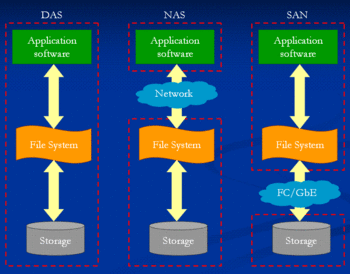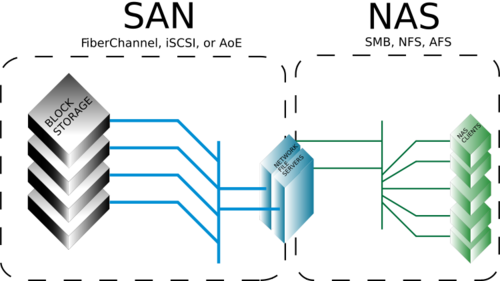Difference between revisions of "Storage Area Network"
m |
m (→Additional reading) |
||
| Line 32: | Line 32: | ||
*[[image:PDF-logo.png|25px]][http://www.snia.org/education/storage_networking_primer/education/storage_networking_primer/stor_virt/sniavirt.pdf Storage virtualization by SNIA] | *[[image:PDF-logo.png|25px]][http://www.snia.org/education/storage_networking_primer/education/storage_networking_primer/stor_virt/sniavirt.pdf Storage virtualization by SNIA] | ||
* [http://www.snia.org/education/ SNIA education WEB. Lots of god stuff] | * [http://www.snia.org/education/ SNIA education WEB. Lots of god stuff] | ||
| − | *[[ | + | *[[SAN Design Considerations|Cisco CCDP Storage Area Network]] |
Revision as of 05:27, 15 August 2009
Definition
1. A network whose primary purpose is the transfer of data between computer systems and storage elements and among storage elements.
A SAN consists of a communication infrastructure, which provides physical connections, and a management layer, which organizes the connections, storage elements, and computer systems so that data transfer is secure and robust. The term SAN is usually (but not necessarily) identified with block I/O services rather than file access services.
2. A storage system consisting of storage elements, storage devices, computer systems, and/or appliances, plus all control software, communicating over a network.
The SNIA definition specifically does not identify the term SAN with Fibre Channel technology. When the term SAN is used in connection with Fibre Channel technology, use of a qualified phrase such as "Fibre Channel SAN" is encouraged. According to this definition, an Ethernet-based network whose primary purpose is to provide access to storage elements would be considered a SAN. SANs are sometimes also used for system interconnection in clusters.
- definition source Storage Networking Industry Association (SNIA) definition
- SNIA's] full definition of a SAN
See also
Network Attached Storage (NAS)
Differences between a SAN and a NAS
- A NAS is defined by SNIA as
- systems that provide file services to host computers using file access protocols
- A SAN is is defined by SNIA as
- The term SAN is usually (but not necessarily) identified with block I/O services rather than file access services.
Conclusion
- A NAS can always be called a SAN
- A SAN can not necessarily be called a NAS unless it offers File Services via a network.
A NAS using a SAN backend
It is possible for a NAS to use a SAN backend as displayed in picture 2.

